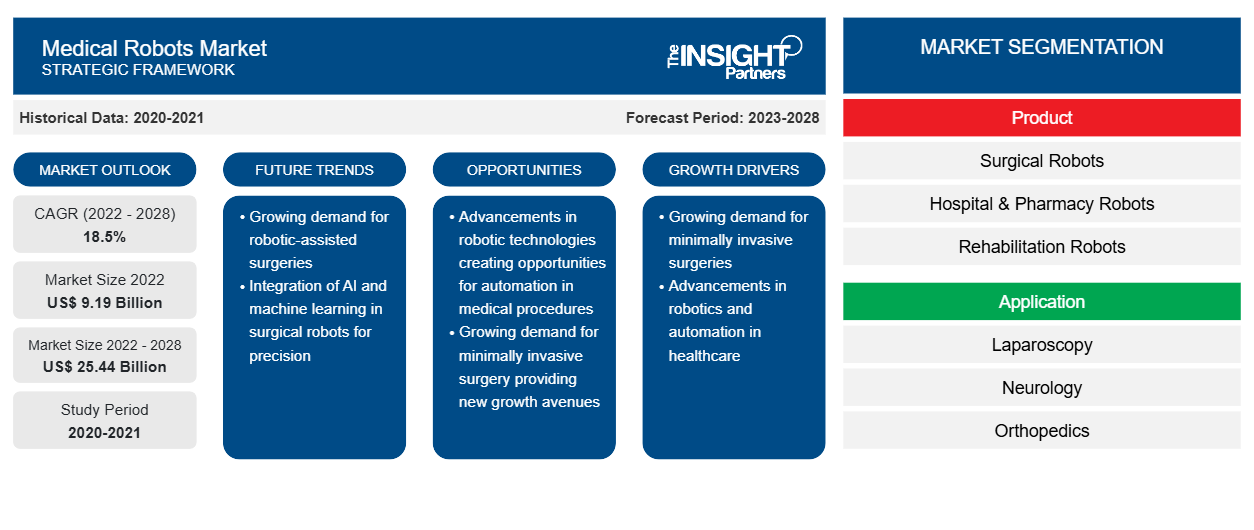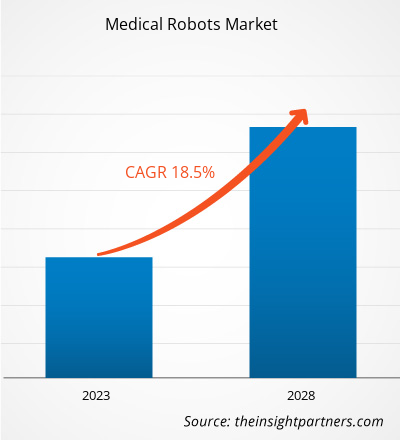医疗机器人市场规模预计将从 2022 年的 91.897 亿美元增至 2028 年的 254.4336 亿美元;预计 2022 年至 2028 年的复合年增长率为 18.5%。ectimated value of US$ 9,189.70 million in 2022; it is expected to grow at a CAGR of 18.5% from 2022 to 2028.
预计手术数量的增加以及产品上市和批准数量的增加将推动医疗机器人市场的发展。然而,手术和安装的高成本阻碍了市场的增长。
医疗机器人专为专门的医疗应用而设计。这些机器人可以执行各种医疗任务,例如手术、医学检测和患者监护。它们可以完全根据外科医生的术前计划进行手术。医疗机器人使开放式和微创手术具有高精度。它们还大大减少了手术所需的时间。此外,医疗机器人还可用于将患者从医院的一个位置运送到另一个位置。用于远程护理的机器人、用于减少医院内感染的消毒机器人以及用于康复训练的机器人外骨骼(提供外部支持和肌肉训练)都是医疗机器人应用的例子。医疗保健领域的机器人技术最早于 1985 年使用,尽管直到 2000 年,达芬奇机器人才获得美国 FDA 批准用于执行外科手术。达芬奇机器人因其在心脏手术、头颈手术和泌尿外科手术中的应用而广为人知。
在预测期内,北美很可能占据医疗机器人市场的主导地位。美国在 2022 年占据了北美市场的最大份额,预计在预测期内将继续保持这一趋势。根据美国代谢和减肥外科学会 2022 年发布的一项研究,美国在过去十年中见证了减肥手术约 62.0% 的增长。此外,根据美国医疗保健研究和质量机构 2017 年发布的研究,美国每年进行约 70 万例全膝关节置换手术。据估计,如此大量的手术为采用先进的医疗设施提供了有利的环境,这将在预测期内推动美国医疗机器人市场的发展。
定制此报告以满足您的需求
您可以免费定制任何报告,包括本报告的部分内容、国家级分析、Excel 数据包,以及为初创企业和大学提供优惠和折扣
- 获取此报告的关键市场趋势。这个免费样品将包括数据分析,从市场趋势到估计和预测。
医疗机器人市场根据产品、应用、最终用户和地理位置进行细分。按地理位置划分,市场大致分为北美、欧洲、亚太地区、中东和非洲以及南美和中美洲。医疗机器人报告提供了对市场的见解和深入分析,强调了市场趋势、技术进步、市场动态和全球领先市场参与者的竞争分析等参数。
市场洞察
手术次数多
全球范围内的手术数量正在增加。过去 25 年来,欧洲国家的心血管疾病发病率有所上升。在该地区,糖尿病病例的增加和生活方式的改变正在增加心血管手术和普通手术的数量。
癌症和糖尿病是全球死亡的主要原因之一。根据美国癌症协会 (ACS) 的一项研究,2021 年,美国诊断出约 190 万例新癌症病例。根据荷兰癌症登记处的数据,2021 年,荷兰登记了约 123,672 例新癌症病例。此外,根据国际糖尿病联合会 (IDF) 的数据,2021 年,全球估计有 5.37 亿人患有糖尿病。预计到 2045 年,这一数字将达到 7.83 亿。
根据美国代谢和减肥手术协会发布的研究,2019 年,美国进行了约 252,000 例减肥手术。手术数量的增加产生了对机器人手术器械的需求。因此,慢性病的惊人患病率和手术数量的增加产生了对机器人手术器械的需求。
产品洞察
根据产品,全球医疗机器人市场细分为手术机器人、康复机器人、非侵入性放射手术机器人、医院和药房机器人等。手术机器人细分为神经外科手术机器人系统、心脏病外科手术机器人系统、腹腔镜手术机器人系统和骨科手术机器人系统。2022 年,手术机器人细分市场占据了最大的市场份额。机器人手术是使用机器人手术系统进行的外科手术。手术机器人是自动化和计算机控制的医疗设备,经过编程可协助定位和操纵手术器械,这些手术机器人可帮助外科医生执行复杂的外科手术。这些机器人能够增强外科医生进行开放手术的能力。因此,手术机器人可以通过微创方式以更高的精度执行复杂而先进的外科手术。然而,康复机器人细分市场预计将在预测期内实现最高复合年增长率。
应用程序洞察
根据应用,全球医疗机器人市场细分为腹腔镜检查、神经内科、骨科、妇科、泌尿科、心脏病科等。2022 年,腹腔镜检查领域占据了最大的市场份额。然而,预计神经内科领域在预测期内的复合年增长率最高。腹腔镜检查是一种用于检查腹部内器官的外科诊断程序。机器人手术是一种微创手术,只需要小切口,风险低。2000 年,达芬奇手术系统成为 FDA 批准用于一般腹腔镜手术的第一个机器人手术系统。最新的高端型号是达芬奇 Xi。医疗机器人的部署提高了腹腔镜手术的效率。2022 年 1 月,一个机器人在没有人类引导的情况下对猪的软组织进行了腹腔镜手术。随着医疗领域越来越多地采用腹腔镜手术,拥有一个专为此类手术设计的自动化机器人系统来协助手术将变得非常重要。近年来,腹腔镜手术越来越受青睐的主要原因之一是医疗保健行业逐渐放弃开放手术。由于上述所有因素,腹腔镜手术市场在未来几年可能会增长。
最终用户洞察
根据最终用户,全球医疗机器人市场分为医院、门诊手术中心和其他。2022 年,医院部门占据了最大的市场份额。此外,由于医疗机器人在外科手术中的医疗优势和使用率的提高以及手术过程中机器人性能的提高,预计同一部门在预测期内将在市场上实现最高的复合年增长率。
产品发布和合作是全球医疗机器人市场参与者广泛采用的策略,以扩大其全球影响力和产品组合。参与者还专注于合作战略以扩大客户群,这反过来又使他们能够在全球范围内保持自己的品牌名称。他们的目标是通过开发创新产品来扩大市场份额。以下列出了一些最近的关键市场发展:
- 2022 年 2 月,为医院、长期护理和零售药房提供商提供医疗保健解决方案的领先创新者 Capsa Healthcare 收购了 Humanscale Healthcare,后者是一家总部位于纽约的灵活技术解决方案和计算工作站的设计商和制造商。
- 2022 年 1 月,Omnicell, Inc. 推出了 Reimaging IV Station,这是一款全自动 IV 配药机器人,可正面解决行业问题,同时提供患者安全性、准确性、成本节省、供应链控制和合规性优势。
- 2021 年 10 月,Accuray 推出了精准治疗计划系统,使用户能够轻松规划、优化质量并高效提供治疗。VOLO Ultra 是计划解决方案 Accuray 精准治疗计划系统的最新发展。它有助于加速 Radixact 和 TomoTherapy 治疗,使临床医生每天可以治疗更多患者。它包括一个最先进的优化器,采用现代快速的基于梯度的算法,可为每次治疗提供最佳计划质量。
- 2021 年 6 月,ARxium 在里尔大学医院推出了一款机器人“RIVA”,用于准备注射化疗药物。
医疗机器人市场区域洞察
Insight Partners 的分析师已详细解释了预测期内影响医疗机器人市场的区域趋势和因素。本节还讨论了北美、欧洲、亚太地区、中东和非洲以及南美和中美洲的医疗机器人市场细分和地理位置。

- 获取医疗机器人市场的区域特定数据
医疗机器人市场报告范围
| 报告属性 | 细节 |
|---|---|
| 2022 年市场规模 | 91.9亿美元 |
| 2028 年市场规模 | 254.4 亿美元 |
| 全球复合年增长率(2022 - 2028) | 18.5% |
| 史料 | 2020-2021 |
| 预测期 | 2023-2028 |
| 涵盖的领域 | 按产品
|
| 覆盖地区和国家 | 北美
|
| 市场领导者和主要公司简介 |
|
医疗机器人市场参与者密度:了解其对业务动态的影响
医疗机器人市场正在快速增长,这得益于终端用户需求的不断增长,而这些需求又源于消费者偏好的不断变化、技术进步以及对产品优势的认识不断提高等因素。随着需求的增加,企业正在扩大其产品范围,进行创新以满足消费者的需求,并利用新兴趋势,从而进一步推动市场增长。
市场参与者密度是指在特定市场或行业内运营的企业或公司的分布情况。它表明在给定市场空间中,相对于其规模或总市场价值,有多少竞争对手(市场参与者)存在。
在医疗机器人市场运营的主要公司有:
- 雅培
- F.霍夫曼-罗氏有限公司
- Immunexpress 公司
- 屋宇署
- 丹纳赫
免责声明:上面列出的公司没有按照任何特定顺序排列。

- 了解医疗机器人市场顶级关键参与者概况
医疗机器人——市场细分
全球医疗机器人市场根据产品、应用和最终用户进行细分。就产品而言,全球医疗机器人市场细分为手术机器人、康复机器人、非侵入性放射外科机器人、医院和药房机器人等。根据应用,全球医疗机器人市场细分为腹腔镜、神经内科、骨科、妇科、泌尿科、心脏病科等。就最终用户而言,医疗机器人市场细分为医院、门诊手术中心等。
公司简介
- 直观外科公司
- 史赛克公司
- 霍科马公司
- 美敦力
- Auris Health, Inc.
- Accuray 公司
- Omnicell 公司
- 阿克西姆
- Ekso Bionics 控股公司
- 柯比莱斯特有限责任公司。
- 历史分析(2 年)、基准年、预测(7 年)及复合年增长率
- PEST 和 SWOT 分析
- 市场规模价值/数量 - 全球、区域、国家
- 行业和竞争格局
- Excel 数据集



Report Coverage
Revenue forecast, Company Analysis, Industry landscape, Growth factors, and Trends

Segment Covered
This text is related
to segments covered.

Regional Scope
North America, Europe, Asia Pacific, Middle East & Africa, South & Central America

Country Scope
This text is related
to country scope.
常见问题
The pandemic of coronavirus disease 2019 (COVID-19) has increased hospital resource us. As a result, health care systems are overburdened, and the delivery of medical care to all patients has become a challenge in the region. In addition, medical device industry is also facing negative impact of this pandemic. As the COVID-19 pandemic continues to unfold, medical device companies are finding difficulties in managing their operations. Many companies offering medical robots have their business operations in the United states and business are adversely being affected by the effects of a widespread outbreak of COVID-19. This has disrupted and restricted company’s ability to distribute products, as well as temporary closures of company’s facilities. However, gradually hospitals have started resuming elective procedures as the COVID-19 recovery rate is increasing the demand for medical equipment like medical robots is expected to increase.
In 2022, North America is likely to account for the largest share in the global medical robots market. However, Asia Pacific is projected to grow at a faster pace over the forecast period. The growth of the medical robots market in this region is primarily due to increasing number of minimally invasive surgeries in Japan and China, due to the rise in the medical tourism in India, and the growth in the initiatives taken by government to enhance the usage of medical robots.
The medical robots market majorly consists of players such as Intuitive Surgical, Inc., Stryker Corporation, Hocoma AG, Medtronic, Auris Health, Inc., Accuray Incorporated, Omnicell Inc., Arxium, Ekso Bionics Holdings, Inc., ad Kirby Lester LLC among others.
Intuitive Surgical, Inc., and Stryker Corporation are the top two companies that hold huge market shares in the medical robots market.
The surgical robots segment is likely to for the largest share in the global medical robots market by product owing to key factors like rise of technological innovations in robotic systems to increase their efficiency and utility, rapid advancements in surgical robots, rising demand for minimal invasive surgical procedures, advantages of robotic assisted surgeries, the post-surgery benefits, and rising per capita healthcare spending in emerging countries.
The CAGR value of the medical robots market during the forecasted period of 2022-2028 is 18.5%.
Medical robots are designed to assist surgeons during the surgical procedures. Medical robots are professional service robots that are used inside and outside of the hospital settings to progress the overall level of patient care. They reduce the workload of healthcare staff, enabling them to spend more time caring directly to patients while creating substantial operational procedure which provides efficacy and reduced cost investments for healthcare amenities. The medical robots are majorly used for surgical producers, there are different types of medical robots. The types of the medical robots include surgical robots, rehabilitation robots, hospital & pharmacy robots, and more.
The use of the medical robots is more in countries of US as the technological advancement is matured and is highly involved in the research and developments for the healthcare and medical industries. The Canada is also a matured market for the medical robotics as the rise in the support by the government for the developments of the medical equipment is rising with the help of financial support. However, the Mexico is the late adopter of the medical robots still the market is likely to propel significantly in the forecasted period due to the advantages provided by the medical robots.
Trends and growth analysis reports related to Life Sciences : READ MORE..
The List of Companies - Medical Robots Market
- Abbott
- F. Hoffmann-La Roche Ltd.
- Immunexpress Inc.
- BD
- Danaher
- Luminex Corporation
- Thermo Fisher Scientific Inc.
- bioMerieux SA.
- T2 Biosystems, Inc.
- Axis-Shield Diagnostics Ltd.
The Insight Partners performs research in 4 major stages: Data Collection & Secondary Research, Primary Research, Data Analysis and Data Triangulation & Final Review.
- Data Collection and Secondary Research:
As a market research and consulting firm operating from a decade, we have published and advised several client across the globe. First step for any study will start with an assessment of currently available data and insights from existing reports. Further, historical and current market information is collected from Investor Presentations, Annual Reports, SEC Filings, etc., and other information related to company’s performance and market positioning are gathered from Paid Databases (Factiva, Hoovers, and Reuters) and various other publications available in public domain.
Several associations trade associates, technical forums, institutes, societies and organization are accessed to gain technical as well as market related insights through their publications such as research papers, blogs and press releases related to the studies are referred to get cues about the market. Further, white papers, journals, magazines, and other news articles published in last 3 years are scrutinized and analyzed to understand the current market trends.
- Primary Research:
The primarily interview analysis comprise of data obtained from industry participants interview and answers to survey questions gathered by in-house primary team.
For primary research, interviews are conducted with industry experts/CEOs/Marketing Managers/VPs/Subject Matter Experts from both demand and supply side to get a 360-degree view of the market. The primary team conducts several interviews based on the complexity of the markets to understand the various market trends and dynamics which makes research more credible and precise.
A typical research interview fulfils the following functions:
- Provides first-hand information on the market size, market trends, growth trends, competitive landscape, and outlook
- Validates and strengthens in-house secondary research findings
- Develops the analysis team’s expertise and market understanding
Primary research involves email interactions and telephone interviews for each market, category, segment, and sub-segment across geographies. The participants who typically take part in such a process include, but are not limited to:
- Industry participants: VPs, business development managers, market intelligence managers and national sales managers
- Outside experts: Valuation experts, research analysts and key opinion leaders specializing in the electronics and semiconductor industry.
Below is the breakup of our primary respondents by company, designation, and region:

Once we receive the confirmation from primary research sources or primary respondents, we finalize the base year market estimation and forecast the data as per the macroeconomic and microeconomic factors assessed during data collection.
- Data Analysis:
Once data is validated through both secondary as well as primary respondents, we finalize the market estimations by hypothesis formulation and factor analysis at regional and country level.
- Macro-Economic Factor Analysis:
We analyse macroeconomic indicators such the gross domestic product (GDP), increase in the demand for goods and services across industries, technological advancement, regional economic growth, governmental policies, the influence of COVID-19, PEST analysis, and other aspects. This analysis aids in setting benchmarks for various nations/regions and approximating market splits. Additionally, the general trend of the aforementioned components aid in determining the market's development possibilities.
- Country Level Data:
Various factors that are especially aligned to the country are taken into account to determine the market size for a certain area and country, including the presence of vendors, such as headquarters and offices, the country's GDP, demand patterns, and industry growth. To comprehend the market dynamics for the nation, a number of growth variables, inhibitors, application areas, and current market trends are researched. The aforementioned elements aid in determining the country's overall market's growth potential.
- Company Profile:
The “Table of Contents” is formulated by listing and analyzing more than 25 - 30 companies operating in the market ecosystem across geographies. However, we profile only 10 companies as a standard practice in our syndicate reports. These 10 companies comprise leading, emerging, and regional players. Nonetheless, our analysis is not restricted to the 10 listed companies, we also analyze other companies present in the market to develop a holistic view and understand the prevailing trends. The “Company Profiles” section in the report covers key facts, business description, products & services, financial information, SWOT analysis, and key developments. The financial information presented is extracted from the annual reports and official documents of the publicly listed companies. Upon collecting the information for the sections of respective companies, we verify them via various primary sources and then compile the data in respective company profiles. The company level information helps us in deriving the base number as well as in forecasting the market size.
- Developing Base Number:
Aggregation of sales statistics (2020-2022) and macro-economic factor, and other secondary and primary research insights are utilized to arrive at base number and related market shares for 2022. The data gaps are identified in this step and relevant market data is analyzed, collected from paid primary interviews or databases. On finalizing the base year market size, forecasts are developed on the basis of macro-economic, industry and market growth factors and company level analysis.
- Data Triangulation and Final Review:
The market findings and base year market size calculations are validated from supply as well as demand side. Demand side validations are based on macro-economic factor analysis and benchmarks for respective regions and countries. In case of supply side validations, revenues of major companies are estimated (in case not available) based on industry benchmark, approximate number of employees, product portfolio, and primary interviews revenues are gathered. Further revenue from target product/service segment is assessed to avoid overshooting of market statistics. In case of heavy deviations between supply and demand side values, all thes steps are repeated to achieve synchronization.
We follow an iterative model, wherein we share our research findings with Subject Matter Experts (SME’s) and Key Opinion Leaders (KOLs) until consensus view of the market is not formulated – this model negates any drastic deviation in the opinions of experts. Only validated and universally acceptable research findings are quoted in our reports.
We have important check points that we use to validate our research findings – which we call – data triangulation, where we validate the information, we generate from secondary sources with primary interviews and then we re-validate with our internal data bases and Subject matter experts. This comprehensive model enables us to deliver high quality, reliable data in shortest possible time.


 获取此报告的免费样本
获取此报告的免费样本